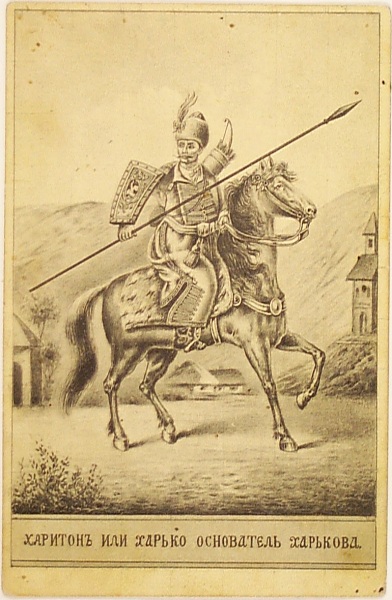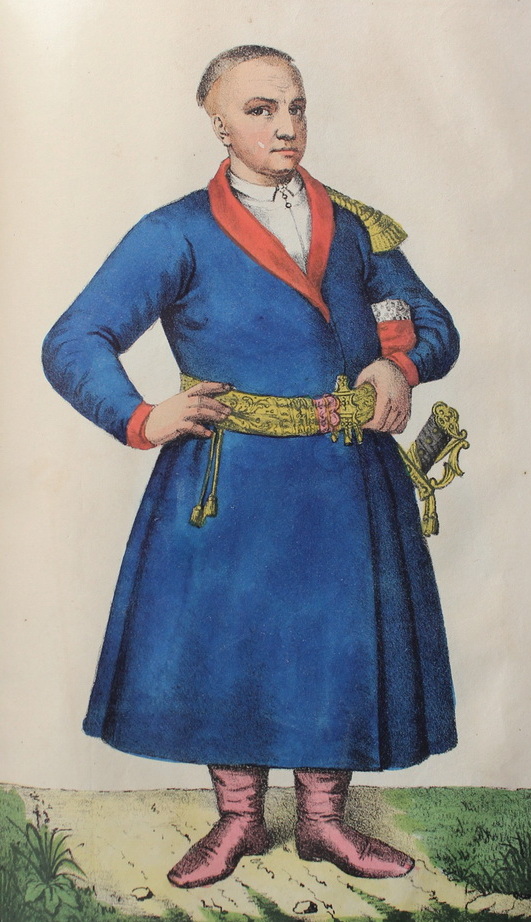|
Kharkiv Regiment
The Kharkiv Sloboda Cossack Regiment ( uk, Харківський слобідський козацький полк) was one of five territorial-administrative subdivisions of the Sloboda Ukraine. The regiment's capital was the city of Kharkiv, now in Kharkiv Oblast of Eastern Ukraine. The Kharkiv Regiment appeared between 1651 and 1659 years. In 1732 it consisted of 19 sotnias. In 1765, the sloboda regiments was abolished, and its territory was reformed into the Sloboda Ukraine Governorate. Preconditions of appearance The settlement of future regimental lands by settlers from the territory of the Polish–Lithuanian Commonwealth took place against the backdrop of uninterrupted military operations in the Dnieper and Western Ukraine, burdened by punitive expeditions of the Polish–Lithuanian Commonwealth, as well as by fratricidal civil war involving foreign troops (Tatars and Turks). The first wave of immigrants from the Right Bank Ukraine to the territory of the Moscow king ... [...More Info...] [...Related Items...] OR: [Wikipedia] [Google] [Baidu] |
Sotnia
Sotnia ( Ukrainian and ) was a military unit and administrative division in many Slavic countries. Sotnia, deriving back to 1948, has been used in a variety of contexts in both Ukraine and Russia to this day. It is a helpful word to create short names for groups including the Nebesna Sotnia and Terek Wolf Sotnia, stating that these groups do include 100-150 persons. The military unit analog and most meaningful translation for the English-speaking world would be a company. Its significance can be notice its nationalist impact within the 16th-18th century Cossacks Ukrainian People’s Republic, Ukrainian National Army, and during Euromaidan. Sotnia can also be referred to as half-sotnia which is a more diminutive unit of people. This typically consists of around 50 people. In Russian history, was also a unit of some other (civil) organizations, see Сотня. History and application Cossacks As a unit of the Cossack regiments, it is known from the earliest records of th ... [...More Info...] [...Related Items...] OR: [Wikipedia] [Google] [Baidu] |
Universal (act)
Universal ( pl, Uniwersał; uk, Універсал) is a historic term that means an official proclamation or legal act. In several historic periods Universals were issued in the Polish–Lithuanian Commonwealth by the Polish and later also by Ukrainian authorities. The name originates from Latin ''litterae universales'', meaning universal publication directed to all. The term was recently revived in modern Ukraine where the Universal of National Unity, a political multiparty agreement signed on August 3, 2006, ended a parliamentary crisis. Poland Universals were issued by the kings and governing authorities of the Kingdom of Poland and the Polish–Lithuanian Commonwealth. In the Commonwealth, a universal could be a letter from the king read publicly to address significant events or a legal act by the king related to economic, military or religious matters. Universals were also routinely used to call the szlachta to assemble for a Sejm, or to report for pospolite ruszenie (or ... [...More Info...] [...Related Items...] OR: [Wikipedia] [Google] [Baidu] |
History Of Kharkiv
Kharkiv ( uk, Ха́рків, ), also known as Kharkov (russian: Харькoв, ), is the second-largest city and municipality in Ukraine.Kharkiv "never had eastern-western conflicts" '' Euronews'' (23 October 2014) Located in the northeast of the country, it is the largest city of the historic region. Kharkiv is the administrative centre of |
History Of Kharkiv Oblast
Kharkiv Oblast ( uk, Харківська́ о́бласть, translit=Kharkivska oblast), also referred to as Kharkivshchyna ( uk, Ха́рківщина), is an oblast (province) of eastern Ukraine. The oblast borders Russia to the north, Luhansk Oblast to the east, Donetsk Oblast to the south-east, Dnipropetrovsk Oblast to the south-west, Poltava Oblast to the west and Sumy Oblast to the north-west. The area of the oblast is 31,400 km², corresponding to 5.2% of the total territory of Ukraine. The oblast is the third most populous province of Ukraine, with a population of 2,633,834 in 2021, more than half (1.43 million) of whom live in the city of Kharkiv, the oblast's administrative center. While the Russian language is primarily spoken in the cities of Kharkiv oblast, elsewhere in the oblast most inhabitants speak Ukrainian. Geography The oblast borders Russia (Belgorod Oblast) to the north, Luhansk Oblast to the east, Donetsk Oblast to the south-east, Dnipropetrovsk Ob ... [...More Info...] [...Related Items...] OR: [Wikipedia] [Google] [Baidu] |
Filaret Gumilevsky
Archbishop Filaret (Филарет Гумилевский, born Dmitry Grigorievich Gumilevsky; 1805-1866) was the Russian Orthodox Bishop of Riga (1841–48), Archbishop of Kharkov (1848–59), and Archbishop of Chernigov (1859–66). The son of a priest from the Shatsk district, Filaret is best known as a theologian and church historian. At the precocious age of 30 he was appointed Dean of the Moscow Theological Academy based in the Troitse-Sergiyeva Lavra. During his tenure in Riga (1841-1848) the Governorate of Livonia saw a religious conversion movement, as a result of which more than one hundred thousand Estonian and Latvian peasants converted to Orthodoxy. He also established a school in Riga in February 1846, which grew four years later into a seminary (Latvian: ''Rīgas Garīgais seminārs''). His magnum opus is ''The History of the Russian Church'' (1847–48), the first complete and systematic outline of the evolution of the Russian Orthodox Church. It was seen as a c ... [...More Info...] [...Related Items...] OR: [Wikipedia] [Google] [Baidu] |
Khorunzhy
Standard-bearer (Polish: ''Chorąży'' ; Russian and Ukrainian: , ''khorunzhiy''; ; ) is a military rank in Poland, Ukraine and some neighboring countries. A ''chorąży'' was once a knight who bore an ensign, the emblem of an armed troops, a voivodship, a land, a duchy, or a kingdom. This function later evolved into a non-hereditary noble title. From the end of the 14th century in the Kingdom of Poland and the Grand Duchy of Lithuania, and later in the Polish–Lithuanian Commonwealth, there were four "central" ''chorąży'' positions: * Grand Standard-Bearer of the Crown; * Grand Standard-Bearer of Lithuania; * Court Standard-Bearer of the Crown; * Court Standard-Bearer of Lithuania. At the same time, ''chorąży'' was also an honorary office in a land. From the 16th century, ''Chorąży'' was the title of the military leader of a Cossack community, and later a rank in the Cossack Hosts. The rank, written "хорунжий" (khorunzhiy) in Russian, was officially recogni ... [...More Info...] [...Related Items...] OR: [Wikipedia] [Google] [Baidu] |
Osavul
Yesaul, osaul or osavul (russian: есау́л, translit=yesaul, uk, осаву́л, translit=osavul) (from Turkic yasaul - ''chief''), is a post and a rank in the Ukrainian Cossack units. The first records of the rank imply that it was introduced by Stefan Batory, King of Poland in 1576. Cossacks in Russia There were different yesaul posts and ranks in Cossack Hosts in Imperial Russia: *Генеральный есаул (''generalny yesaul'') - General Yesaul *Походный есаул (''pokhodny yesaul'') - Campaign Yesaul *Войсковой есаул (''voiskovoy yesaul'') - Army Yesaul *Полковой есаул (''polkovoy yesaul'') - Regimental Yesaul *Артиллерийский есаул (''artilleriysky yesaul'') - Artillery Yesaul *Сотенный есаул (''sotenny yesaul'') - Company Yesaul (commander of a sotnia) *Станичный есаул (''stanichny yesaul'') - Yesaul of a stanitsa Cossack Hetmanate and Sloboda Ukraine In Ukraine of the 17th an ... [...More Info...] [...Related Items...] OR: [Wikipedia] [Google] [Baidu] |
Otaman
Ataman (variants: ''otaman'', ''wataman'', ''vataman''; Russian: атаман, uk, отаман) was a title of Cossack and haidamak leaders of various kinds. In the Russian Empire, the term was the official title of the supreme military commanders of the Cossack armies. The Ukrainian version of the same word is ''hetman''. ''Otaman'' in Ukrainian Cossack forces was a position of a lower rank. Etymology The etymologies of the words ''ataman'' and ''hetman'' are disputed. There may be several independent Germanic and Turkic origins for seemingly cognate forms of the words, all referring to the same concept. The ''hetman'' form cognates with German ''Hauptmann'' ('captain', literally 'head-man') by the way of Czech or Polish, like several other titles. The Russian term ''ataman'' is probably connected to Old East Slavic ''vatamanŭ,'' and cognates with Turkic ''odoman'' (Ottoman Turks). The term ''ataman'' may had also a lingual interaction with Polish ''hetman'' and German ''h ... [...More Info...] [...Related Items...] OR: [Wikipedia] [Google] [Baidu] |
Otaman
Ataman (variants: ''otaman'', ''wataman'', ''vataman''; Russian: атаман, uk, отаман) was a title of Cossack and haidamak leaders of various kinds. In the Russian Empire, the term was the official title of the supreme military commanders of the Cossack armies. The Ukrainian version of the same word is ''hetman''. ''Otaman'' in Ukrainian Cossack forces was a position of a lower rank. Etymology The etymologies of the words ''ataman'' and ''hetman'' are disputed. There may be several independent Germanic and Turkic origins for seemingly cognate forms of the words, all referring to the same concept. The ''hetman'' form cognates with German ''Hauptmann'' ('captain', literally 'head-man') by the way of Czech or Polish, like several other titles. The Russian term ''ataman'' is probably connected to Old East Slavic ''vatamanŭ,'' and cognates with Turkic ''odoman'' (Ottoman Turks). The term ''ataman'' may had also a lingual interaction with Polish ''hetman'' and German ''h ... [...More Info...] [...Related Items...] OR: [Wikipedia] [Google] [Baidu] |
Sotnik
Sotnik or sotnyk (, uk, сотник, bg, стотник) was a military rank among the Cossack '' starshyna'' (military officers), Strelets Troops (17th century) in Muscovy and Imperial Cossack cavalry (since 1826), the Ukrainian Insurgent Army, the Ukrainian Galician Army, and the Ukrainian People's Army. Administrative rank Holders of the rank also served as leaders of territorial units. In the Cossacks' paramilitary society of the Zaporozhian Host, Cossack Hetmanate, and Sloboda Ukraine, territories were organized along the lines of military organization and commanded by officers. During the Khmelnytsky Uprising and in the Cossack Hetmanate (17th-18th centuries), ''sotnyks'' were leaders of territorial administrative subdivisions called ''sotnyas''. Such sotnyks were subordinated to ''polkovnyks'' (colonel) who were in control of a polk (primary administrative division) and a regiment (military unit). Military ranks The word ''sotnik'' literally means ''commander of a hun ... [...More Info...] [...Related Items...] OR: [Wikipedia] [Google] [Baidu] |
Khorugv
Khorugv (russian: хоругвь, bg, хоругва, cu, хорѫгꙑ, uk, хоругва, pl, chorągiew, ro, prapur, fi, kirkkolippu, sometimes translated as ''gonfalon'')Historically, the Russian word ''khorugv'', as well as Polish ''choragiew'' also referred to a military banner in the secular sense, and the corresponding detachment associated with it. Derived from this word are the Polish "Chorągiew" (an administrative unit), as well as the military ranks Chorąży in Poland or Khorunzhiy among Russian Cossacks. is a religious banner used liturgically in the Eastern Orthodox and Eastern Catholic Churches. The khorugv or banner consists of an icon of Christ, the Theotokos or a saint, either painted or embroidered on a rectangular piece of cloth. The cloth is often pointed or swallow-tailed, or has several streamers coming down from it. The banner often has two or three tails on it, each terminating in a tassel, and may be fringed around the edges. It is suspended from ... [...More Info...] [...Related Items...] OR: [Wikipedia] [Google] [Baidu] |
Ratusha
In local government, a city hall, town hall, civic centre (in the UK or Australia), guildhall, or a municipal building (in the Philippines), is the chief administrative building of a city, town, or other municipality. It usually houses the city or town council, its associated departments, and their employees. It also usually functions as the base of the mayor of a city, town, borough, county or shire, and of the executive arm of the municipality (if one exists distinctly from the council). By convention, until the middle of the 19th century, a single large open chamber (or "hall") formed an integral part of the building housing the council. The hall may be used for council meetings and other significant events. This large chamber, the "town hall" (and its later variant "city hall") has become synonymous with the whole building, and with the administrative body housed in it. The terms "council chambers", "municipal building" or variants may be used locally in preference t ... [...More Info...] [...Related Items...] OR: [Wikipedia] [Google] [Baidu] |







